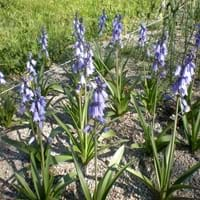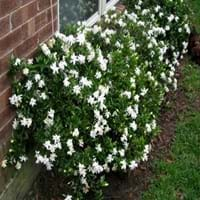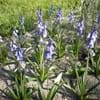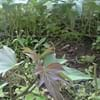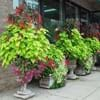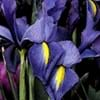Life Span
Perennial
Perennial
Type
Bulb or Corm or Tuber
Broadleaf Evergreen
Origin
Southern Europe, Western Europe, Northern Africa
Eastern Asia
Types
Hyacinthoides flahaultiana, Hyacinthoides mauritanica, Hyacinthoides reverchonii
G. 'Radicans', G. 'Aimee',G. 'Golden Magic'
Habitat
Parks, wastelands, Waysides, Woodland edges
Subtropical climates, Temperate Regions
USDA Hardiness Zone
4-10
7-10
AHS Heat Zone
9-1
Not Available
Habit
Clump-Forming
Oval/Rounded
Flower Color
White, Blue, Pink, Blue Violet
White, Ivory
Flower Color Modifier
Bicolor
Bicolor
Fruit Color
Not Available
Orange Red, Brown
Leaf Color in Spring
Green
Dark Green
Leaf Color in Summer
Light Green
Dark Green
Leaf Color in Fall
Several shades of Green
Dark Green
Leaf Color in Winter
Light Green
Dark Green
Leaf Shape
Narrow
Lance shaped
Plant Season
Spring
Spring, Summer, Fall, Winter
Sunlight
Partial Sun, Partial shade
Full Sun, Partial Sun
Growth Rate
Medium
Medium
Type of Soil
Loam
Loam, Sand
The pH of Soil
Acidic, Neutral
Acidic, Neutral
Soil Drainage
Well drained
Well drained
Bloom Time
Spring, Late Spring
Late Spring, Early Summer, Summer, Late Summer
Tolerances
Drought
Not Available
Where to Plant?
Ground
Container, Ground, Pot
How to Plant?
By dividing rhizomes, tubers, From bulbs, Seedlings
Cuttings, Tip cutting
Plant Maintenance
Medium
Medium
Watering Requirements
Average Water Needs, Do Not over Water, Requires regular watering
Keep the Soil well drained, Needs less watering, Requires consistently moist soil, Use Mulches to help prevent water loss during hot and windy weather
In Summer
Lots of watering
Average Water
In Spring
Moderate
Moderate
In Winter
Average Water
Average Water
Soil pH
Acidic, Neutral
Acidic, Neutral
Soil Type
Loam
Loam, Sand
Soil Drainage Capacity
Well drained
Well drained
Sun Exposure
Partial Sun, Partial shade
Full Sun, Partial Sun
Pruning
Pinch Tips, Remove damaged leaves, Remove dead branches, Remove dead leaves, Remove dead or diseased plant parts
Remove damaged leaves, Remove dead branches, Remove dead leaves
Fertilizers
High amounts of nutrients, organic fertlizers
All-Purpose Liquid Fertilizer
Pests and Diseases
Red blotch
Aphids, Mealy bugs, Spider mites, Whiteflies
Plant Tolerance
Drought
Not Available
Flower Petal Number
Single
Double
Foliage Texture
Medium
Medium
Foliage Sheen
Glossy
Glossy
Attracts
Birds, Butterflies, pollinators
Birds, Butterflies
Allergy
Pollen
Hay fever, Mild Allergen
Aesthetic Uses
Showy Purposes
Beautification, Bouquets, Informal Hedge, Showy Purposes
Beauty Benefits
Not Available
Not Available
Environmental Uses
Air purification
Air purification
Medicinal Uses
Not Available
chest congestion, cholesterol-lowering, Detoxification
Part of Plant Used
Flowers
Flowers, Fruits
Other Uses
Beneficial species for attracting pollinators, Decoration Purposes, Showy Purposes, Used for Landscaping
Cake, Can be boiled and seasoned, pickled, Jam, Used as preservative
Used As Indoor Plant
No
Yes
Used As Outdoor Plant
Yes
Yes
Garden Design
Container, Cutflower, Mixed Border, Rock Garden / Wall, Wildflower
Container, Cutflower, Feature Plant, Foundation, Houseplant, Mixed Border, Topiary, Bonsai, Espalier
Botanical Name
HYACINTHOIDES hispanica
GARDENIA jasminoides 'Frostproof'
Common Name
Spanish Bluebell
Cape Jasmine, Frostproof Gardenia, Gardenia
In Hindi
Bluebell plant
Gardenia jasminoides
In German
Endymion Pflanze
Gardenie
In French
plante Bluebell
Cape Jasmine
In Spanish
planta Bluebell
Gardenia jasminoides
In Greek
φυτό Bluebell
Cape Jasmine
In Portuguese
planta Bluebell
Gardenia jasminoides
In Polish
Bluebell roślin
Gardenia jaśminowata
In Latin
Bluebell herba
Gardenia mucronata
Phylum
Magnoliophyta
Tracheophyta
Class
Liliopsida
Magnoliopsida
Order
Liliales
Gentianales
Family
Liliaceae
Rubiaceae
Genus
Hyacinthoides
Gardenia
Clade
Angiosperms, Monocots
Angiosperms, Asterids, Eudicots
Tribe
Hyacintheae
Not Available
Subfamily
Scilloideae
Not Available
Number of Species
Not Available
Season and Care of Bluebell and Cape Jasmine
Season and care of Bluebell and Cape Jasmine is important to know. While considering everything about Bluebell and Cape Jasmine Care, growing season is an essential factor. Bluebell season is Spring and Cape Jasmine season is Spring. The type of soil for Bluebell is Loam and for Cape Jasmine is Loam, Sand while the PH of soil for Bluebell is Acidic, Neutral and for Cape Jasmine is Acidic, Neutral.
Bluebell and Cape Jasmine Physical Information
Bluebell and Cape Jasmine physical information is very important for comparison. Bluebell height is 30.00 cm and width 15.00 cm whereas Cape Jasmine height is 105.00 cm and width 135.00 cm. The color specification of Bluebell and Cape Jasmine are as follows:
Bluebell flower color: White, Blue, Pink and Blue Violet
Bluebell leaf color: Green
Cape Jasmine flower color: White and Ivory
- Cape Jasmine leaf color: Dark Green
Care of Bluebell and Cape Jasmine
Care of Bluebell and Cape Jasmine include pruning, fertilizers, watering etc. Bluebell pruning is done Pinch Tips, Remove damaged leaves, Remove dead branches, Remove dead leaves and Remove dead or diseased plant parts and Cape Jasmine pruning is done Remove damaged leaves, Remove dead branches and Remove dead leaves. In summer Bluebell needs Lots of watering and in winter, it needs Average Water. Whereas, in summer Cape Jasmine needs Average Water and in winter, it needs Average Water.
